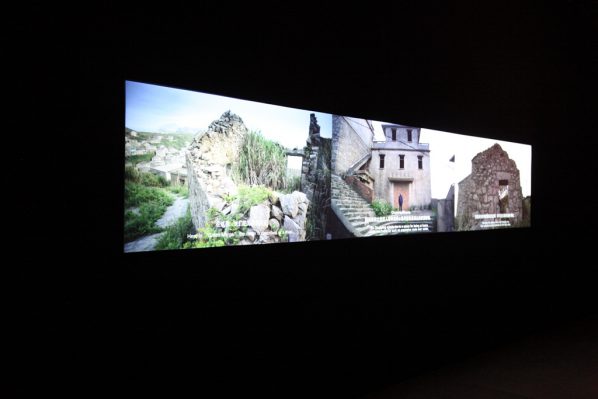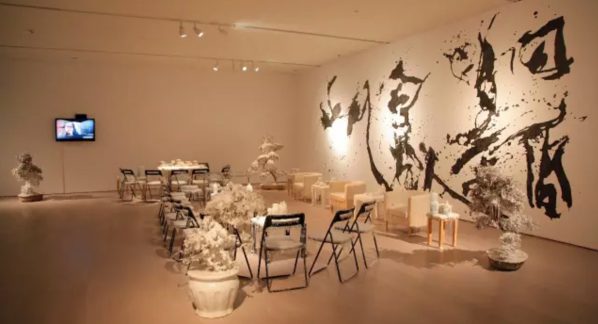
The “Shan-Shui?山水” (mountain and water) spirit mirrors the ultimate harmony between man and nature that Chinese people have been after for thousands of years. Symbolizing the spiritual dwelling that is brimming with poetic vision and ideal, it could be traced back to the utopian land that was depicted as Peach Blossom Spring; has always been rooted in the traditional and modern delineation of landscape; and can be perceived in the attempts to reflect on and probe into the society in the contemporary context.
When the past, the present and the future meet, our perception, experience and imagination inevitably and intricately intertwine. In the context of contemporary China, the nation’s dramatic development has led to not only material prosperity but also drastically growing desires. Under such a backdrop, what kind of?Shan-Shui?society would artists envision as a model for the future?
In?Peach Blossom Spring – The Imagery of the Past,?landscape paintings (high-resolution reproductions) by Xie Shichen (1487- 1567) and He Haixia (1908 -1998), two renowned Chinese landscape painters during the Ming Dynasty and modern times respectively, are put on display, forming a prelude to the poetically intriguing?Shan-Shui context that would elegantly remind people of the long-lasting pursuit for the harmonious state among man, nature and the society.
As time goes by, unprecedentedly drastic changes have been witnessed in the present day. As a result, the cultural root for traditional?Shan-Shui?spirit seems to have been on the verge of disappearance. Under such a circumstance, how to revive and reconstruct the social value and significance of it? Resorting to their personal experience and insight, the artists manage to give their response in a visual way, inspiring more people to pay attention to issues highly pertinent to the sustainability of human society.

Yangjiang Group (Zheng Guogu, Chen Zaiyan, Sun Qinlin), Shan-shui conference with tea and aroma, 2015; Installation with synthetic materials, Dimensions Variable
In the second section of the exhibition,?Metamorphosis – The Imagery of the Reality, a contemporary and somehow conceptual picture of modern “l(fā)andscape” is presented. In?Rubbing Drought, the seemingly abstract brushwork stands for the arid riverbed of the Yellow River, the “mother river” of China. The familiar and yet strange images remind people of the increasing deterioration of the environment. Likewise, Wang Jiuliang presents a different landscape of the cities and nature, a landscape of garbage. It takes viewers a closer look to realize that what constitutes the beautiful “l(fā)andscape” is actually all garbage. Environmental problems are often closely related with the obvious fact seen in China – urbanization. Ni Weihua’s photography and video installation show the skylines of China’s megacities, luxury buildings and lavish gardens, in front of which are those migrants who have flocked into the cities during the dramatic process of urbanization. Surrounded by the glory of cities, but at the same time, they are actually very far from urban life. The constant deconstruction and reconstruction have become a source of inspiration for Yang Yongliang. Under the surface of the seemingly natural landscape, it is the hustle and bustle of urban “cityscape” that dominates his work. Yangjiang Group (led by Zheng Guogu, Chen Zaiyan and Sun Qinglin) manages to bring a fragment of artificial nature into the exhibition hall through their visually stunning installation. Yuan Shun’s installation and photography show a fantasy land featuring an abstract imagery of traditional Chinese landscape. It’s hard to tell whether these sci-fi-like pictures illustrate the ruin of the past or a vision of the future.

Hu Xiangcheng, Where is the Way Home, 2014-2015; video
With the increasing overlapping of the virtual world and the real one, a more diverse and illusory multi-layered depiction of the globalized world emerges, unleashing a torrent of freedom and potential that have never been imagined before. In?Shan-Shui Society – The Imagery of the Future, the third section of the exhibition, artists/architects including Dai Zhikang, Chen Bochong and Ma Yansong share their vision of a future?Shan-Shui society in a variety of forms including sketches, architectural model and dialogues, creating an inviting environment to engage people in the exploration of an unknown and yet charismatic future model of the society.
From the delineation of the natural landscape, to the probe into problems that are commonly faced by contemporary people, and then to the presentation of a humanistic approach with a somewhat futuristic touch, the exhibition intends to depict a constantly evolving imagery to inspire more reflection and cast light on an insight to the future in the language of visual art.
About the exhibition
Organized by: Shanghai Himalayas Museum, Riverside Art Museum
Duration: December?18, 2016 – February 20, 2017
Venue: Riverside Art Museum (Beijing)
Commissinor: Dai Zhikang
Curator:?Wong Shun-kit
Artists:?He Haixia, Xie Shichen, Wang Nanming, Wang Jiuliang, Ni Weihua, Gao Shiqiang, Yuan Shun, Yang Yongliang, Hu Xiangcheng, Yangjiang Group (Zheng Guogu, Chen Zaiyan, Sun Qinglin), Lee Maelee( Korea), Chen Bochong, Ma Yangsong
Courtesy of the artists and Shanghai Himalayas Museum, for further information please visit www.himalayasart.cn.




























